Physical Address
304 North Cardinal St.
Dorchester Center, MA 02124
Radiographs are an essential tool in the initial assessment of most conditions affecting the foot, whether they are acute or chronic traumatic lesions or infectious, inflammatory, or neoplastic conditions. Standard views include anteroposterior, lateral, and external oblique projections. Assessment of developmental or acquired osseous malalignment and evaluation of the arch require radiographs taken with the patient bearing weight on the affected extremity. A sesamoid view may supplement standard radiographs when evaluating the first metatarsophalangeal (MTP) joint.
CT offers more precise cortical, trabecular, and articular bone detail in the assessment of a fracture, post-fracture deformity, fracture healing, arthritis, osteonecrosis, or neoplasm. Multidetector CT permits acquisition of 1-mm-thick slices in a single plane, with high-resolution reformatted images typically generated in three orthogonal planes.
Ultrasonography offers a high-resolution, targeted examination, ideal for evaluating tendinopathy, capsulitis, bursitis, Morton neuroma, or retained foreign body and is ideal for guiding therapeutic injection. The dynamic, real-time nature of ultrasonography enhances the evaluation of myotendinous or ligamentous injury and adds important information, differentiating clinically silent from symptomatic abnormalities. MRI of the forefoot permits a small field of view, high-resolution imaging to answer specific clinical questions that may have eluded diagnosis by radiographs, CT, and ultrasonography. This is particularly useful in the assessment of occult osseous and soft tissue pathology around the MTP joints and within the intermetatarsal and submetatarsal soft tissues.
Dedicated forefoot imaging is best accomplished by using small-diameter quadrature or surface coils. Short-axis (coronal plane) imaging through the forefoot is ideal for the evaluation of MTP capsuloligamentous structures as well as hallucal sesamoids and for the assessment of Morton neuroma and intermetatarsal bursitis. Long-axis (axial plane) imaging demonstrates the tarsometatarsal joints, metatarsal shafts, and MTP joints and is particularly useful for the evaluation of a metatarsal stress fracture. Sagittal imaging complements the coronal and axial planes and may be optimized by selecting an obliquity off of the axial localizer to correspond to the metatarsal or ray of clinical interest.
The first MTP joint differs from the lesser MTP joints in that there is a compound articulation, both between the first metatarsal head and between the metatarsal head and the hallucal sesamoids. The sesamoids act as shock absorbers, limit abduction at the first MTP joint, and function to transfer pressure from the skin surface to the metatarsal head by acting as a pulley, unloading and increasing the mechanical advantage of the flexor tendons of the great toe. The sesamoids straddle the crista, a longitudinal bony ridge at the plantar surface of the first metatarsal head, which serves to limit mediolateral displacement of the sesamoids and encourages their sagittal plane motion at the first MTP joint ( Fig. 36-1 ). The hallucal sesamoids may be bipartite or, less commonly, multipartite. They ossify by the age of 10 years, and, commonly, the medial one is larger than the lateral.
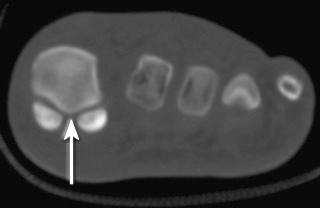
Four sets of paired ligaments run between the first metatarsal head, the sesamoids, and the proximal phalanx; together with the plantar MTP, the intersesamoid, and the deep transverse ligaments, these stabilize the first MTP joint. Medial and lateral slips of the flexor hallucis brevis tendon attach to the sesamoids before inserting on the medial and lateral margins of the proximal phalanx. All but the articular surfaces of the hallucial sesamoids are embedded within the fibrocartilaginous plantar plate. The sesamoids are bound to each other by the intersesamoid ligament portion of the plantar plate (see eFig. 36-1 ). The tibial sesamoid is further stabilized by attachments of the abductor hallucis tendon, whereas the fibular sesamoid is stabilized by attachments from the adductor hallucis tendon. The tendon of the flexor hallucis longus is cradled between the hallucal sesamoids, plantar to the intersesamoid ligament. The fibrous joint capsule surrounds the entire first MTP joint and attaches to the sesamoids at the joint's plantar aspect.

Hallux valgus, one of the commonest painful foot deformities, is defined as the lateral deviation of the hallux at the level of the first metatarsophalangeal joint with further medial deviation of the first metatarsal. It is often accompanied by widening of the first intermetatarsal angle. It is typically an acquired forefoot deformity, four times more common in women than men. Genetic predisposition, trauma, and arthritic changes primarily influence the development of hallux valgus, although high-heeled footwear and shoes with tight toe boxes are thought to be contributory factors.
There is associated fibular deviation and pronation of the hallux with prominence of the dorsomedial eminence of the first metatarsal. With deviation of the great toe, the exposed articular cartilage at the medial aspect of the first metatarsal head undergoes disuse atrophy, laying the bone bare to external forces of footwear. Bony erosion and proliferation ensue, enlarging the prominence or bony bunion at the dorsomedial eminence of the first metatarsal head. An adventitious bursa, or soft tissue bunion, may develop overlying the dorsomedial eminence, formed by the body to cushion the acquired bony prominence. Bursitis, dorsomedial cutaneous nerve compression, or even skin ulceration are recognized complications.
Evaluation of this condition is performed exclusively by conventional radiographs, including weight-bearing anteroposterior and lateral views. Non-weight-bearing oblique and sesamoid views are often acquired as important additional information can be obtained. The various views and their descriptions are as follows:
Anteroposterior view is used for various measurements of forefoot alignment.
The lateral view is useful for evaluating dorsal deviation of the first metatarsal, bone proliferation, and the orientation of the dorsal aspect of the first and second metatarsal bones, which should demonstrate a normal parallel relationship.
The oblique view optimally demonstrates the dorsomedial eminence of the head of the first metatarsal.
The sesamoid view permits assessment of the first metatarsal-sesamoid cartilage space and alignment, which are commonly abnormal in the context of hallux valgus.
Radiologists play an important role in evaluating the various angular deformities, which have a significant implication on the surgical management of patients. The following is a summary of different angles measured:
Hallux valgus: between the long axis of the first metatarsal and the first proximal phalanx (normal is <15 degrees). It is the main indicator of severity ( Fig. 36-2 ).
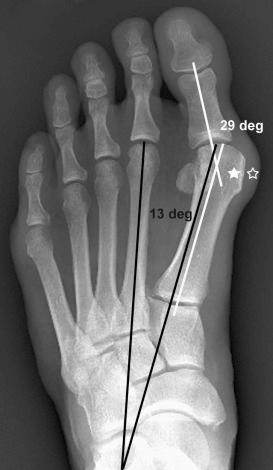
First and second intermetatarsal angle: between the long axis of the first and second metatarsals (normal is between 8 and 12 degrees). Widening of this angle may require corrective osteotomy of the proximal or distal part of the first metatarsal or sometimes both, depending on the severity (see Fig. 36-2 ).
Interphalangeal angle: between the long axis of the proximal phalanx and the distal phalanx (normal is <10 degrees). Overlooking this deformity can overestimate the degree of the hallux valgus deformity leading to surgical overcorrection. Communicating this finding can alert the surgeon for possible corrective phalangeal osteotomy.
Proximal articular set angle (proximal articular set degree of lateral orientation of the head of the metatarsal): between a line perpendicular to the long axis of the first metatarsal and line connecting two points delineating the orientation of the articular surface of the metatarsal head (normal is from 0 to 8 degrees). An abnormal angle may require a metatarsal osteotomy to realign the metatarsal articular surface ( eFig. 36-2 ).
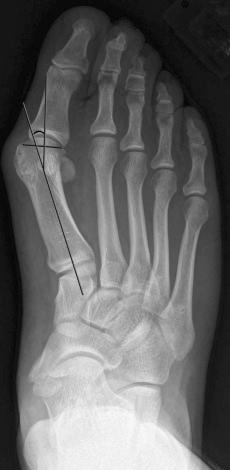
Distal articular set angle: similar to proximal articular set and measures the orientation of the articular surface of the proximal phalanx, that is, a line perpendicular to the long axis of the proximal phalanx and line connecting two points delineating the orientation of the articular surface of the base of the proximal phalanx (normal is <8 degrees). An abnormal angle may require phalangeal osteotomy to realign the articular surface ( eFig. 36-3 ).
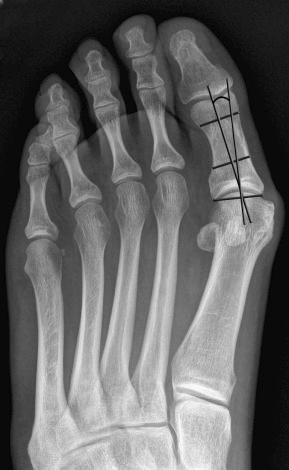
Hallux valgus is associated with overpronation of the first ray and fibular subluxation of the sesamoids ( Fig. 36-3 ). Lateral subluxation renders the sesamoids useless in preventing abduction of the great toe. Over time, chondromalacia of the sesamoids and pressure erosion of the crista develop. Soft tissue imbalance at the first metatarsophalangeal joint ensues with accommodative stretching of the medial and tightening of the lateral ligamentous structures, resulting in a mechanical advantage of the muscles on the lateral side and increasing the severity of hallux valgus.
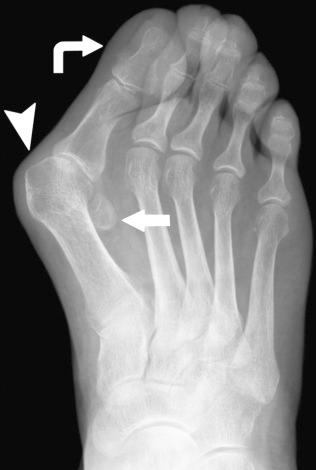
Become a Clinical Tree membership for Full access and enjoy Unlimited articles
If you are a member. Log in here